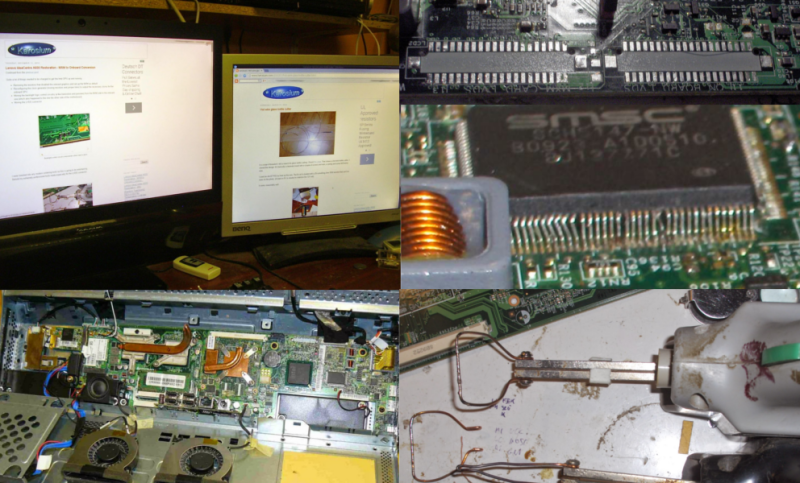While browsing a local auction site, [Viktor] found himself bidding on a beat up Lenovo A600 all-in-one PC. He bid around $50 and won. Then came the hard part – actually making the thing work. The front glass was cracked, but the LCD was thankfully unharmed. The heat pipes looked like they had been attacked with monkey wrenches. The superIO chip’s pins were mangled, and worst of all, the MXM video card was dead.
The first order of business was to fix the superIO chip’s pins and a few nearby discrete components which had been knocked off their pads. Once that was done, [Viktor] was actually able to get the computer to boot into Linux from a USB flash drive. The next step was bringing up the display. [Viktor] only needed a coding station, so in addition to being dead, the video accelerator on the MXM wasn’t very useful to him. The Lenovo’s motherboard was designed to support video on an MXM card or internal video. Switching over meant changing some driver settings and moving a few components, including a rather large LVDS connector for the display itself. A difficult task, compounded by the fact that [Viktor’s] soldering tools were a pair of soldering guns that would be better suited to fixing the bodywork on a ’57 Chevy. He was able to fashion a hot wire setup of sorts, and moved the connector over. When he was done, only one tiny solder bridge remained!
The end result is a new coding battle station for [Viktor] and a computer which was a basket case is saved from the landfill. If you like this hack, check out [Viktor’s] low power PSU, or his 1 wire network!
















Until quite recently, all I had to solder with was a 200W soldering gun. This dude deserves some serious respect!! Absolutely amazing what he’s managed with some beat-up old tools. Nice hack!
Good on him for mucking in and making in a project, but I can’t help think that he didn’t save very much considering the time that he must have spent on it…I suppose it depends on what the goal of the project was.
You can buy these in pristine shape for $150 so no, he did not save anything. But he learned a ton about the design and found some clever repair techniques that will help in the future.
And honestly any time you can say, “I fixed this destroyed thing, what did you do today?” is a win.
Old laptops are often a source of amusement when the desoldered graphics chip is repaired.
Still have one here which is going after close to 3 years despite the beast being totally dead when I got it.
If anyone wants an all-in-one Acer with the same (ie dead) problem, sometimes works if you press the chip during bootup.
This is really stunning work. Not only the use of his soldering “cannons” but also his persistence and hard work sifting through all these schematics only to repair a rather old machine.
Well done.
And for his next trick he’s going to make a positronic brain from some 555s and a pepsi can! Nice work and @Fennec I think the challenge of the repair was part of the fun for him.
you can’t buy mxm boards. they have all different specs. manufacturers failed to adopt because they want to make more money forcing you buying a new notebook rather than upgrading the graphic card.
I felt pretty good replacing all the caps on a $10 Hp Sff Core2Duo thrift store find, Your luck, troubleshooting skills, and patience are off the charts, nice work!
yay,I submitted this hack to had tip email, glad it got posted
I was very surprised he didnt have to hack the bios, usually those things are hardcoded (acer laptops) and moving jumpers on the motherboard is not enough.
Very impressive hack, not to mention good for the environment :)
Kudos (and amazement) for this guy’s hard work and persistance. That said, at the very outside max, the CPU in this machine is only 8 years old; while I realize that in “tech years” this is a bit dated, I can’t really bring myself to call this an “old machine”. I am glad it was saved from the landfill.
Core2 is pretty much good enough for every day work
you can even play modern games if you overclock the crap out of one (mine is running at 3.8GHz now)